By Sally Douglas
At the heart of Christian faith is the wild proclamation that in the person of Jesus “all the fullness of God was pleased to dwell” (Col 1:19).
All the fullness. On the deepest of levels, if this is true, this means that in Jesus’ living and being as recorded in the Gospels—in Jesus’ teaching and serving, feasting with and feeding, healing and befriending, liberating, challenging, and exposing evil, and in Jesus’ nonviolent dying and rising in forgiveness—we encounter the fullness of who and how God is.
This reality requires not simply our intellectual acquiescence, or the recitation of particular words.
Instead, this demands the transformation of our understandings of God, the reshaping of our priorities and the remaking of the contours of our relationships, as we continue to look to—and seek to be with—this One.
Perhaps this is why in the church we often prefer to slice off and preserve those aspects of Jesus that fit most easily within our own existing narratives …
Time and again we Christians tend to whittle down our images of Jesus to reflect various versions of our own image, or the images of those who hold power.
We see this pattern of crafting Jesus into our preferred likeness expressed in a multiplicity of ways.
In the West, there is stubborn insistence upon pretending that Jesus is white.
For churches soaked in anti-Semitism, Jesus’ Jewishness is eradicated.
Across cultures and denominations, churches who wish to avoid Jesus’ disruptive call in the Gospels to live in radical generosity and in solidarity with the poor, focus on Jesus’ crucifixion and emphasise life in the realm beyond death.
For those denominations who seek only an ethics-based Christianity, claims about Jesus’ divinity in the New Testament are minimised.
All around the globe, in Christian churches in which patriarchal power structures dominate, androcentric constructions of God-as-male prevail.
This is despite the reality that, as we will discover, the New Testament evidence indicates that Jesus is celebrated in the language and imagery of the female divine in the earliest church.
Destructive consequences flow from each of these, and other, habits of making Jesus, the God One, small and conveniently packaged to fit within our own lives with minimal inconvenience.
This book does not seek to challenge the multitude of idols that the church has made.
Instead, we will explore just one aspect of the fullness of Jesus, as the fullness of God—an aspect that has been ignored and minimised for century upon century … As we will trace together, within the biblical text, in the Gospels, in the letters, and in some of the earliest evidence we have in Christianity (hymn and prayer fragments embedded within these New Testament texts), again and again Jesus is celebrated in the language and imagery of the female divine … who is called Woman Wisdom or Sophia.
For too long clergy, church members, theologians, the curious, the angry, and the searchers have been deprived of this disruptive, nourishing, and orthodox understanding of Christian faith.
This year’s Australian Christian Book of the Year winner will be announced on August 22


